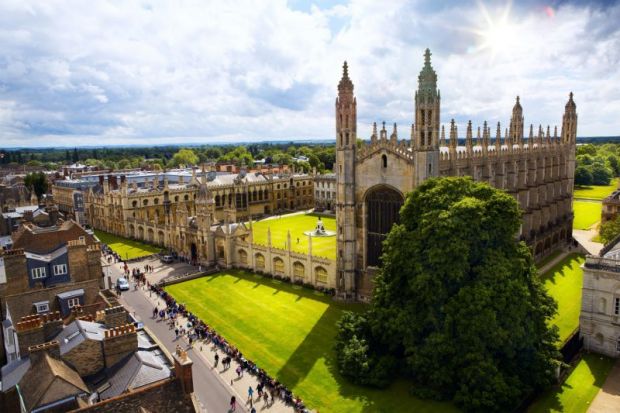Durham and Cambridge are among the English higher education institutions drawing the lowest levels of students from the regions in which they are located, recruiting just over 10 per cent of their UK intake from the north east and east of England respectively.
The Times Higher Education analysis, of unpublished figures on universities’ recruitment by region provided by the Higher Education Statistics Agency (Hesa), comes as the UK government’s focus on “levelling up” in the regions puts the local contributions of universities under scrutiny.
Durham University has the lowest levels of recruitment in its region, with just 10.1 per cent of its UK first-degree full-time students coming from the north east in 2018-19.
It was followed by the University of Warwick (13.1 per cent of UK students from the West Midlands), Loughborough University (13.1 per cent from the East Midlands), the University of Cambridge (13.4 per cent from the east of England) and the University of Bath (15 per cent from the south west).
Of the 20 English universities in the Russell Group, many of which are highly selective, 15 are in the bottom quartile of all English universities when it comes to the proportion of UK students drawn from their own regions.
Meanwhile, Newman University, the University of Wolverhampton, Edge Hill University and Birkbeck, University of London all drew more than 80 per cent of UK students from their regions.
On the universities doing the least recruitment in their regions, Andy Westwood, professor of government practice at the University of Manchester, said there are “clearly some issues in the East Midlands, north east and West Midlands in both progression rates [into higher education] and broader economic challenges that suggest this might not be an optimal way of functioning – for the institutions themselves or for the sector, funding bodies, regulators and ministers”.
Institutions’ roles in local recruitment and local retention of graduates, and making the economic benefits of universities “much more ‘sticky’ to the places that they exist in”, could be crucial “if regional inequality and low productivity are to be tackled properly”, he added.
Stuart Corbridge, Durham’s vice-chancellor, noted that the north east was the region “with the lowest rate of participation in higher education in England”.
He continued: “We have a large number of programmes to encourage students from the north east of England to apply to study here, or indeed to go on to study at another university, and we are constantly building these programmes and the financial support that underpins them.”
Mike Nicholson, Bath’s director of undergraduate admissions and outreach, explained its low local recruitment by saying the university does not offer courses in law or most of the humanities disciplines, requires “pretty high grades” and half of undergraduates will need “the equivalent of an A level in mathematics” for admission.
“I think we’ve got a significant responsibility to make sure that students who are local to us know about the opportunities that higher education [in general] provides,” said Mr Nicholson, pointing out that Bath hosts the area’s Uni Connect outreach hub. “The question of whether we should be seeking out students locally to come to us if we don’t offer what they are interested in, that’s a very different question.”
A Cambridge spokesman said the university “works hard in the east of England, as it does with schools across the nations and regions of the UK, to encourage all students with the ability and potential to succeed to apply”, is “the main partner" of the Network for East Anglian Collaborative Outreach and runs "our own outreach programmes in schools across Cambridgeshire and Norfolk”.
A Warwick spokesman said its 970 degree apprenticeship students are not included in the Hesa figures, while last year it launched the £10 million Warwick Scholars programme supporting up to 500 Midlands young people to study at the university annually.
A Loughborough spokeswoman said its recruitment is shaped by the fact it is not located in a big city, along with its “strong sporting offer” having national appeal, though it has been involved in programmes “encouraging local students to apply to university”.




